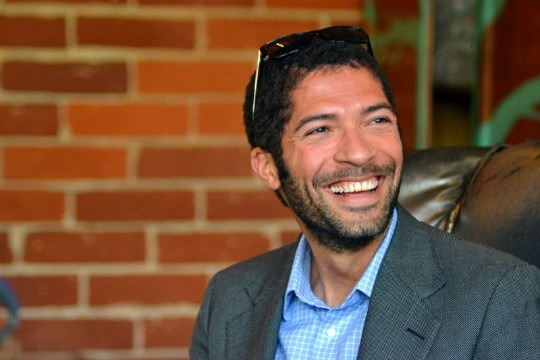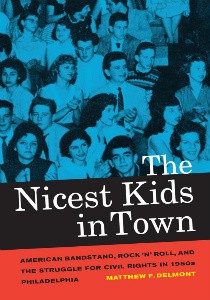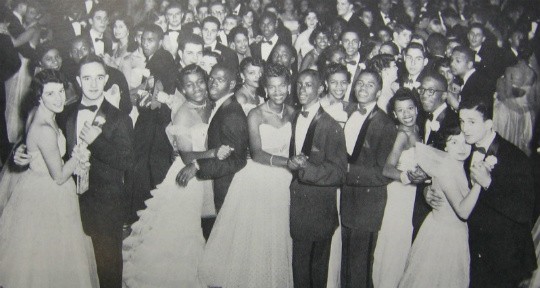
Yesterday, we published the first part of an interview with Matt Delmont, author of The Nicest Kids in Town: American Bandstand, Rock 'n' Roll, and the Struggle for Civil Rights in 1950's Philadelphia, where, contrary to Dick Clark's claims, he reveals how the iconic television show discriminated against black youth during its early years.
Read the first part of the interview with Matt Delmont here; in this second installment, Delmont speaks about the influence of Soul Train, what it would have meant had American Bandstand truly racially integrated its program at the time, and how he hopes his book's findings will be received.
]

OC Weekly (Gabriel San Roman): When Soul Train debuted and proved to be successful, Dick Clark tried to launch a rival program in response, did he not? Does that factor into this book and into your research?
Yeah, definitely. Dick Clark launched a show called “Soul Unlimited” that was going to be hosted by a black deejay out of Los Angeles and it was directly to try to compete with Soul Train. When it got accepted, Don Cornelius partnered up with Jesse Jackson and Operation Push and took the case to ABC and was able to successfully pressure ABC and Dick Clark into dropping the competitor show. It shows up more in the book in terms of it being the first time Dick Clark advances the claim that American Bandstand in its early incarnation was integrated. From '57, when he claims it was integrated, until the early 1970s, he never says anything about the show being integrated. It's not until Soul Train comes and starts to win away viewers and performers that Dick Clark wants to say that he was down with the black community and advocated for them from the get go. Soul Train is interesting here because it becomes their competitor, but also because it starts to conjure this false claim and memory with regards to American Bandstand's initial integration.
What would have been the media imaging importance, given the stature of American Bandstand, had it truly shown black youth on black and white television screens at the time?
It would have been rare. Had Dick Clark integrated American Bandstand in 1957, that would have been a significant move in terms of media representation. You just didn't see teenagers enjoying popular culture peacefully together on television in that era. Now, we know that was happening. We know that black and white teens all across the country were sharing the love of R&B and rock n' roll, you just didn't see that reflected on television. In fact, you saw almost the exact opposite in terms of television representation of various things like the Little Rock school integration crisis, which happened in '57, about a month after Bandstand debuted. You see all these images of interracial clashing. Had Bandstand been integrated, had it entered into that different type of representation, it could have been progressive in the way that Dick Clark had claimed.
Were there any examples of television programs at the time that showed integration?
One of the things I found in my research is that there was a local broadcast teen discussion show called “They Shall Be Heard” that was put on by a civil rights group in Philadelphia in the early 1950's. It was a different format than Bandstand, but it brought together teenagers across racial lines to talk about issues like civil rights. It turns out it only lasted for a year, in part, because they weren't trying to sell any products. They were brought on the air by a time sharing agreement between the school board entity and a television station. Once television time became more lucrative by the mid-50's, that show and similar types of themes disappeared from the airwaves. What came in where things that were much more commercially safe like American Bandstand.

Lastly, as your research examines an iconic pillar of television culture in the U.S., how do you think your book, with its perception-shaking findings, will be received?
I hope it's received well. I think some people will be upset, in part because the point of the book is that we need to be honest about the level of racism in the 1950s. The point actually isn't that Dick Clark should have or could have integrated American Bandstand. I think Philadelphia was a racist city in the 1950s and television was largely a racist medium. I think had he integrated it, it would have been a really huge move. What I'm really taking issue with, though, is this idea that things were somehow better back then than what we used to remember. In cities in the North, Midwest and West, racial segregation was very real. The pressures on television stations to broadcast racial segregation were very real. I'm hoping that people are comfortable owning up to the more serious aspects of our nation's history in regards to race.
I should say, I got an email from Bunny Gibson, one of the main white dancers on Bandstand from '59 to '61. I didn't have a chance to interview her for my project, but she sent me an email and I initially was a little concerned. I thought she was going to be mad that I was bringing this hidden history of Bandstand to light, but she was actually really glad. She told me a story about how her friend who is African-American had tried to get in Bandstand back in the 50's and wasn't able to. She reconnected with her in the 2000s when they went to one of the Bandstand reunions together. She was upset that people have never really brought this actual history of American Bandstand to light. Having her, someone with a direct experience of the show like that, to be happy, I hope that people will receive it that way and that others won't be upset to shatter the more mythic history that Dick Clark has put forward.

Gabriel San Román is from Anacrime. He’s a journalist, subversive historian and the tallest Mexican in OC. He also once stood falsely accused of writing articles on Turkish politics in exchange for free food from DönerG’s!

